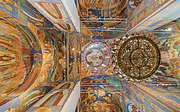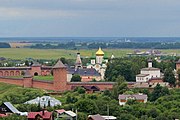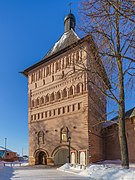The Golden Ring of Russia unites old Russian cities of five Oblasts – usually excluding Moscow – as a well-known theme-route. The grouping is centred northeast of the capital in what was the north-eastern part of ancient Rus'. The ring formerly comprised the region known as Zalesye. The idea of the route and the term was created in 1967 by Soviet historian and essayist Yuri Bychkov, who published in Sovetskaya Kultura in November–December 1967 a series of essays on the cities under the heading: "Golden Ring". Bychkov was one of the founders of ВООПИК: the All-Russian Society for the Protection of Monuments of History and Culture.

The Moscow Kremlin, also simply known as the Kremlin, is a fortified complex in the center of Moscow. It is the best known of the kremlins, and includes five palaces, four cathedrals, and the enclosing Kremlin Wall with Kremlin towers. In addition, within the complex is the Grand Kremlin Palace that was formerly the residence of the Russian emperor in Moscow. The complex now serves as the official residence of the Russian president and as a museum with almost three million visitors in 2017. The Kremlin overlooks the Moskva River to the south, Saint Basil's Cathedral and Red Square to the east, and Alexander Garden to the west.

Rostov is a town in Yaroslavl Oblast, Russia, one of the oldest in the country and a tourist center of the Golden Ring. It is located on the shores of Lake Nero, 202 kilometers (126 mi) northeast of Moscow. Population: 30,406 (2021 Census); 31,792 (2010 Census); 34,141 (2002 Census); 35,707 (1989 Census).

Suzdal is a town that serves as the administrative center of Suzdalsky District in Vladimir Oblast, Russia, which is located near the Kamenka River, 26 kilometers (16 mi) north of the city of Vladimir. Vladimir is the administrative center of the surrounding oblast. As of the 2021 Census, its population was 9,286.

The Solovetsky Monastery is a fortified monastery located on the Solovetsky Islands in the White Sea in northern Russia. It was one of the largest Christian citadels in northern Russia before it was converted into a Soviet prison and labor camp in 1926 to 1939, and served as a prototype for the camps of the Gulag system. The monastery has experienced several major changes and military sieges. Its most important structures date from the 16th century, when Filip Kolychev was its hegumen.
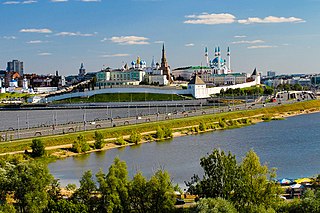
The Kazan Kremlin is the chief historic citadel of Russia, situated in the city of Kazan. It was built at the behest of Ivan the Terrible on the ruins of the former castle of Kazan khans. It was declared a World Heritage Site in 2000.

The architecture of Russia refers to the architecture of modern Russia as well as the architecture of both the original Kievan Rus', the Russian principalities, and Imperial Russia. Due to the geographical size of modern and Imperial Russia, it typically refers to architecture built in European Russia, as well as European influenced architecture in the conquered territories of the Empire.

The architecture of Kievan Rus' comes from the medieval state of Kievan Rus' which incorporated parts of what is now modern Ukraine, Russia, and Belarus, and was centered on Kyiv and Novgorod. Its architecture is the earliest period of Russian architecture, using the foundations of Byzantine culture but with great use of innovations and architectural features. Most remains are Russian Orthodox churches or parts of the gates and fortifications of cities.
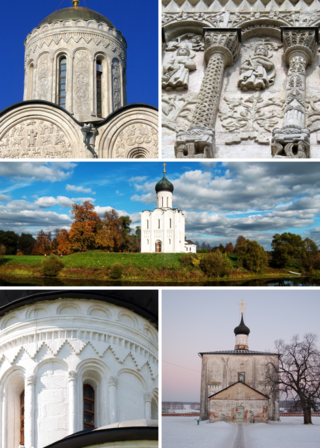
The White Monuments of Vladimir and Suzdal in Vladimir Oblast, Russia, have been designated as a UNESCO World Heritage Site. The patrimony embraces eight medieval limestone monuments of Zalesye from the late 12th and early 13th centuries. They include Russian Orthodox churches and a monastery, as well as a castle and gate:
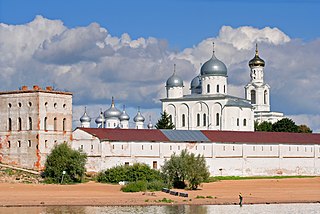
The St. George's (Yuriev) Monastery is usually cited as Russia's oldest monastery. It stands in 5 kilometers south of Novgorod on the left bank of the Volkhov River near where it flows out of Lake Ilmen. The monastery used to be the most important in the medieval Novgorod Republic. It is part of the World Heritage Site named Historic Monuments of Novgorod and Surroundings.
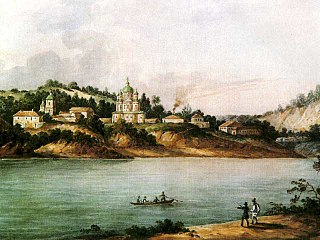
The Mezhyhirya Savior-Transfiguration Monastery was an Eastern Orthodox female monastery that was located in the neighborhood of Mezhyhiria outside of the Vyshhorod city limits.

Monastery of St. Jacob Saviour is an Eastern Orthodox monastery situated to the left from the Rostov kremlin on the Rostov's outskirts.
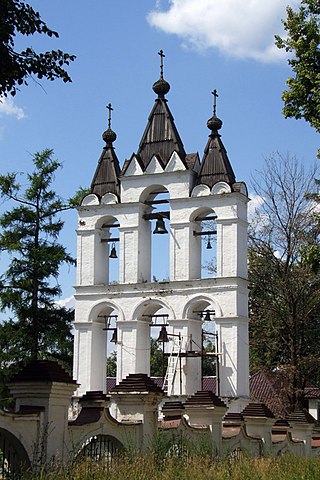
A zvonnitsa is a large rectangular structure containing multiple arches or beams that support bells, and a basal platform where bell ringers stand to perform the ringing using long ropes. It was an alternative to a bell tower in Russian, Polish and Romanian medieval architectural traditions, primarily used in Russian architecture of the 14th-17th centuries. Currently, zvonnitsa are especially widespread in the environs of Pskov.

The Suzdal Kremlin is the oldest part of the city of Suzdal, Russia, dating from the 10th century. Like other Russian kremlins, it was originally a fortress or citadel and was the religious and administrative center of the city. It is most notably the site of the Cathedral of the Nativity.

The Spaso-Prilutsky Monastery is a fortified (walled) Russian Orthodox monastery in the settlement of Priluki on the bank of the Vologda River near the city of Vologda. Its history goes back to the 14th-century missionary activities of St. Sergius of Radonezh and his disciples. Most surviving buildings date from the 16th and 17th centuries. Since 1993 Priluki has been administered as part of Vologda.

The Transfiguration Monastery is a former Russian Orthodox monastery founded in 1192. The monastery is located in the city of Staraya Russa, on the right bank of the Polist River. It is currently occupied by the Staraya Russa Town Museum.

Siberian Baroque is an architectural style common for ambitious structures in 18th-century Siberia, where 115 stone churches in Siberia were recorded in 1803, most of which were built in this provincial variant of the Russian Baroque. Most of the buildings were preserved in Irkutsk, Tobolsk and Tomsk. An original interior of a Siberian Baroque structure survives only in the Feast of the Cross Church in Irkutsk.


